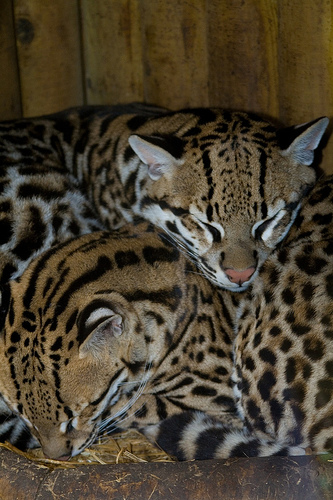
Photo courtesy Flickr user <a href="http://www.flickr.com/photos/craigcullum/474722337/">craigcullens</a> via Creative Commons.
Last week’s cute endangered animal, the Hawaiian Monk Seal, was an ocean creature, so this week’s pick is from the land: the ocelot. The ocelot is a nocturnal wildcat known for its strikingly beautiful coat. The 4′-long, 24 to 35lb animals used to roam from Texas through Louisiana and Arkansas but due to habitat destruction by roads and agriculture, today there are fewer than 100 of the cats in the wild left in the US.
One obstacle to conservation is that like many wild cats, ocelots are solitary and need a large range, 500 acres for a single adult. Ocelots are also picky about what kind of land they will call home: they prefer dense brush with trees (so they can hide and sleep during the day) and need a steady supply of small mammals, rodents, lizards, or other prey to live on. Fun fact: ocelots will pluck all the feathers and fur off their prey before eating it.
Although ocelots are endangered, some people apparently keep them as pets, and they are popular as zoo exhibits. Ocelots seem to do fine in captivity, living up to 20 years: their lifespan in the wild is only seven to 10 years. Though ocelots are endangered in the US, they can be found wild in various parts of Central and South America. The US population, however, has a peculiar enemy: cars. The animals seem to have little concern for traffic running through the nature preserves on which they generally live, and being hit by a car kills 2% of the ocelot population in a given year.
Though the ocelot seems to have little chance for recovery in the US, there is news of a feral population in Florida. Spanish painter Salvador Dali had a pet ocelot named Ozzie, but in general the cats are known to make poor pets. However, those desiring the ocelot’s distinctive coat can settle for the “ocicat”: an entirely domestic cat that looks like an ocelot, but doesn’t have the loudly yowling, aggressively affectionate, spray-happy attributes of its wild cousin. (To hear the growls of an ocelot in heat, click here.)
Follow Jen Phillips on Twitter.











